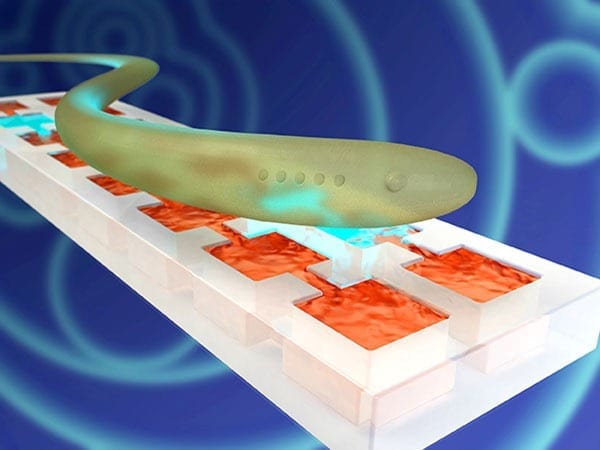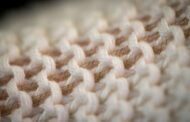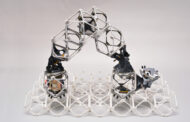
New breakthrough material could lead to future autonomous soft robotics, dual sensors and actuators for soft exoskeletons, or artificial skins. (Courtesy photo)
U.S. Army-funded researchers at Brandeis University have discovered a process for engineering next-generation soft materials with embedded chemical networks that mimic the behavior of neural tissue. The breakthrough material may lead to autonomous soft robotics, dual sensors and actuators for soft exoskeletons, or artificial skins.
The research lays the foundations for futuristic soft active matter with highly distributed and tightly integrated sensing, actuation, computation and control, said Dr. Samuel Stanton, manager of the Complex and Dynamics Systems Program within the Engineering Sciences Directorate at the Army Research Office, an element of the U.S. Army Research Laboratory, located at Research Triangle Park in Durham, North Carolina.
ARO funds research to initiate scientific and far-reaching technological discoveries in extramural organizations, educational institutions, nonprofit organizations and private industry that may make future American Soldiers stronger and safer.
The research team, led by Professor of Physics Dr. Seth Fraden of Brandeis University, drew inspiration from the mesmerizing sinuous motion of a swimming blue eel and puzzlingly large gap between how natural systems move and the lack of such coordinated and smooth movement in artificial systems.
Our research interests lie squarely in the intersection of physics, chemistry, biology and materials science,” Fraden said. “Our lab is interdisciplinary, but we are also involved in several multi-investigator projects.”
Fraden’s work sought to answer key questions, such as why is there such a void between the animate and inanimate that we never confuse the two, and if engineers could create materials with similar attributes to living organisms, but constructed from inanimate objects, can we do so using only chemicals and eschew use of motors and electronics?
Looking deeper, Fraden studied how a type of neural network present in the eel, named the Central Pattern Generator, produces waves of chemical pulses that propagate down the eel’s spine to rhythmically drive swimming muscles.
Fraden’s lab approached the challenge of engineering a material mimicking the generator by first constructing a control device that produces the same neural activation patterns biologists have observed. There, they created a control system that runs on chemical power, as is done in biology, without resorting to any computer or electromechanical devices, which are the hallmarks of manmade, hard robotic technology.
A breakthrough was made when Fraden and his team realized that the same CPG dynamics could be captured on a non-biological platform if they used a well-known oscillating chemical process known as the Belousov–Zhabotinsky reaction. The lab developed state-of-the-art fabrication techniques for soft materials engineering artificial chemical networks at the nanoscale that, altogether, would be capable of producing a wide variety of patterns. Their resulting robust chemical networks produced distributed dynamic patterns identical to the eel’s Central Pattern Generator.
Fraden noted that “the engineering principles they identified are general and can be applied to design a whole range of other Central Pattern Generators, such as those responsible for other autonomous functions, such as the gait of a horse, for example, walk, canter, trot and gallop.”
The research appear as the cover article of the March 7 issue of a U.K. journal, Lab on a Chip, which is a peer-reviewed scientific journal publishing primary research and review articles on any aspect of miniaturization at the micro and nano scale. The work earned distinction as one of the journal’s “hot articles” due to its particularly high scores earned in the scientific review process.
“Enabling a breakthrough in robotic augmentation of high-tempo military maneuver and operations requires disrupting the notion of an intelligent system as a rigid multi-body platform optimized for slow, carefully planned movement in uncluttered terrain,” Stanton said. “Fundamental research is needed to transpose smart materials from the current paradigm of fixed properties and mechanics with extrinsic and centralized control to a new paradigm of soft active composites with unprecedented dynamic functionality realized through maximal substrate embedding of tightly integrated, decentralized, and highly distributed intrinsic (materials-based) sensing, actuation, and control.”
As a next step, Fraden’s lab will take on the challenge of transferring the information coded in the dynamic patterns from the chemical networks to create a targeted mechanical response within a novel chemo-mechanical gel. This could transition the research from artificial material mimicking neural tissue to artificial tissue now mimicking neuromuscular tissue.
Learn more: Scientists mimic neural tissue in Army-funded research
The Latest on: Next-generation soft materials
[google_news title=”” keyword=”next-generation soft materials” num_posts=”10″ blurb_length=”0″ show_thumb=”left”]
via Google News
The Latest on: Next-generation soft materials
- The best Amazon deals to shop this weekend: Save up to 80% on early Mother's Day gifts, tech gadgets, gardening essentials and moreon April 26, 2024 at 1:14 pm
Check out our roundup of the best air purifiers for more.
- What Express filing for bankruptcy signals about Gen Z shopping habitson April 26, 2024 at 12:49 pm
In a news release, the Express CEO signaled that the filing came as the company seeks to strengthen its financial position: “We continue to make meaningful progress refining our product assortments, ...
- A Q&A With Blackie Wills on Dash In’s Next-Generation Storeon April 26, 2024 at 10:49 am
The Wills Group Inc. is opening its Dash In and Splash In ECO Car Wash next-generation store concept throughout the Mid-Atlantic region. And the Indian Head, Maryland, location, which had a soft ...
- How to prep for a layoff you know is comingon April 26, 2024 at 8:29 am
U.S. layoffs rose by 7 percent, up from 84,638 job cuts in February to 90,309, the highest rate since January 2023 as AI-related restructuring continues to make its presence felt across ...
- World's thinnest gold leaf, dubbed 'goldene,' is just 1 atom thickon April 25, 2024 at 12:22 pm
Goldene is the latest 2D material to be made since graphene was first created in 2004. Scientists have created the world's thinnest gold leaf, which is just a single atom thick. The new material, ...
- Magnetic microcoils unlock targeted single-neuron therapies for neurodegenerative disorderson April 23, 2024 at 6:06 pm
Researchers deploy an array of microscopic coils to create a magnetic field and stimulate individual neurons. The magnetic field can induce an electric field in any nearby neurons, the same effect ...
- A prestigious career honor for two elite engineerson April 23, 2024 at 4:07 pm
Professors Beth Pruitt and M. Scott Shell have been named fellows of the American Association for the Advancement of Science ...
- Octopus inspires new suction mechanism for robotson April 19, 2024 at 4:15 pm
A new robotic suction cup which can grasp rough, curved and heavy stone, has been developed by scientists at the University of Bristol. The team, based at Bristol Robotics Laboratory, studied the ...
- An ink for 3D-printing flexible devices without mechanical jointson April 18, 2024 at 10:17 am
EPFL researchers are targeting the next generation of soft actuators and robots with an elastomer-based ink for 3D printing objects with locally changing mechanical properties, eliminating the need ...
via Bing News







